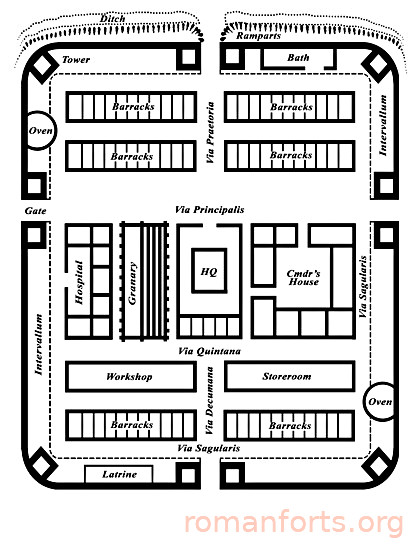
Sectors
Detailed descriptions of the sectors of a generic Roman military installation (forts, fortresses, etc), as defined and used in this study, are given below. The diagram of the generic Roman fort shows possible locations within the site or fort for most of these sectors.
Subsectors from various sectors are noted in the table. These sub-sectors were generally not analyzed in this study, but the data was collected in order to do such micro-analysis in the future, if desired.
Brief Background
The sectors which make up the composite fort are derived from the accepted interpretation of the layout of early to mid-Empire military installations developed by historians and archaeologists over the last 100 or more years. This construct is based upon the results of numerous archaeological investigations, examination of extant monuments such as Trajan's column, and upon the writing of various Roman authors; for example, Hyginus, de munitionibus castrorum (on marching camps), Vegetius, epitoma rei militaris (on the military), and others such as Polybius, Caesar, Arrian and Josephus.
Permanent Roman military installations developed from less permanent marching camps. The layout of these 'playing card shaped' camps is discussed by Hyginus and others. The camp was surrounded by defences with one or two symmetrically placed gates in the defences on each side of the camp. As the need grew for permanent installations, the marching camp layout was modified only slightly and used in permanent installations such as forts, for auxiliary or small units, and fortresses, for the much larger legions. Even relatively tiny installations, such as the fortlets and milecastles along the walls in the north of Roman Britain, tend to conform to this general plan, although with far fewer gates, much shorter walls, and perhaps only a barracks or two inside. Indeed the Roman auxiliary forts and the legionary fortresses in this area quite frequently bear a close resemblance to the idealized layout; although every fort might not have every sector specified in the idealized layout. When they do not, such as at the fort of Bewcastle with its unusual shape, this is generally attributable to the specific circumstances and needs of that particular location. And the fort still has most of the same elements inside it as specified in the commonly accepted interpretation derived from classical authors mentioned above, albeit not in quite the same layout.
Sector Descriptions
| Sector | Description |
|---|---|
| Overall | This sector includes everything inside the site, and the gates, walls, ramparts, and things just outside the walls (the outside sector, see below) of the site. Some site reports only include 'overall' items, as more detailed excavation records were not made, or maintained, when those sites were dug. |
| Annexe | A walled (turf or stone) or ditched (or both) enclosure attached to at least one of the side of a Roman military site. Annexes are generally found with the forts on the Antonine Wall. This sector includes subsectors such as ditches, drains, furnaces, pits, latrines, wells, sumps, ramparts (of the annexe), and gullies. Not included in this sector are bathhouses in the annexe, which are given their own sector for analysis purposes. |
| Barracks/Other | In some excavations a building may be of indeterminate function. The building looks like a barracks, but it may have had other functions and those exact functions were not determined by archaeologists. There are not many sites with these types of buildings in the database, so far. These buildings, which may be barracks, are given the sector name 'Barracks/Other'. Other buildings of indeterminate function which are definitely not barracks are given the sector name 'Workshops, Stables, Storage Building' (see below). |
| Barracks | The barracks were where the soldiers in a unit lived. Each century had its own barracks block, with accommodation for the centurion at one end. In cavalry units it seems as though the barracks housed both the men of the unit and their horses. Possible barracks blocks, those not given other possible uses by the excavator or archaeological analysis, are included in this sector as well as definite barracks blocks. Subsectors found in this sector include drains, pits, latrines, hearths, tanks, gullies and officers' and men's quarters (when noted by the excavator). |
| Baths in Annexe | This sector was created to provide information from bath complexes located in annexes or outside the site and possibly in an annexe. The baths in the Annexe include subsectors such as hot, cold, warm baths, drains, furnaces, pits and hearths. |
| Baths | This sector is made up of baths found inside the site, in the Intervallum, etc. Similar subsectors to those found in the Baths in the Annexe Sector are included here, if they were noted by the excavators or in archaeological analysis. |
| Commander's House |
This sector is the house in which the commander of the unit stationed in the military installation lived. This house was generally a courtyard house (much like a traditional Roman house), with a well or cistern, dining room and various other rooms. Included in this sector are drains, pits, the courtyard well, and so on. |
| Defences | This sector is something of a super-sector. It includes all the sectors which compromise the defences of the installation such as the ramparts, ditches, gates, towers, corners, intervallum and things therein such as drains, pits, gullies, tanks, roads, etc. |
| Ditches | This sector is made up of the ditches of the installation. Note that finds with undecided contexts, such as from a trench excavated over both a ditch and rampart, in which the excavator didn't differentiate between the two, are put in the 'Defences' sector. |
| Drains | The Drains sector includes drains that were not found in any other sector. For example, drains from the barracks are included in the barracks, drains from the rampart in the rampart (and defences), drains from the Commander's House are in the Commander's House, and so on. But in some cases, a drain is isolated or was excavated without reference to another sector. And so the finds from those drains are put into this sector. |
| Granaries/ Storehouses |
Roman forts and fortresses had distinctive buildings known as granaries (elevated for vermin control and air flow for grain storage). They also had storehouses for other goods, buildings which often accompanied granaries. Both types of building could act as one another and the finds from these buildings are put into this sector. Subsectors from this sector include drains and pits. |
| Gates | Gates in the ramparts form this sector. Items from the gates sector are included in the Defences sector as well. Some sub sectors from the gates are aquaducts, drains, etc. |
| Hospital | Not every installation had a hospital (indeed, many forts did not have one as far as we can tell), but for those that did, items from the hospital are put into the Hospital Sector. A subsector from this sector is pits in the hospital building. |
| Headquarters | This sector is formed by items from the headquarters building of the military site. Subsectors of this sector include the basilica, the sacellum, the forecourt, the strongroom, pits, wells, etc... |
| Intervallum | Included in this sector are items from the intervallum of the site. The Intervallum sector has subsectors including drains, latrines, pits, tanks, roads, cooking areas, furnaces, ovens and gullies. Several of these subsectors were examined separately in this study, such as latrines, ovens and roads. |
| Latrine | This sector includes finds from the latrines from inside the installation; generally found along the intervallum, or in the barracks, in a workshop, etc. The finds from latrines inside barracks, workshop and intervallum are included in the barracks, workshop and intervallum totals as well. |
| Outside the Site |
These are items from trenches that were dug just outside the site. This sector does not include items from vici and annexes, which are also outside the site. Some items in this section are also listed in ramparts, etc, because they are from the same trench. Generally 'outside the site' items come from very near the ramparts, ditches, gates, and corners of the site. |
| Ovens | These items are from the ovens found in the site. These ovens are almost always in the intervallum. Oven finds are not included in the Defence sector, but they are included in the Intervallum sector. |
| Ramparts | This sector if formed by the ramparts of the installation. The items from this sector are also included in the Defences sector. Drains, gullies, towers, etc, are sub-sectors of Ramparts sector as well. |
| Roads | The roads of the installation form this sector. These roads include all the named roads of the site such as Via Sagularis, Via Praetoria, Via Principalis, etc. Finds from the intervallum road (Via Sagularis) are also included in the Intervallum sector totals. |
| Towers | The towers in the corners of the site compose this sector. They are also included in the Defences sector. Gates, of course, also had towers, but those finds are generally in the 'gate' itself, as the tower is now archaeologically non-existent. |
| Unknown | This sector is made from buildings of unknown or undetermined function from the site. |
| Vicus | The vicus of the site (generally a fort for now) forms this sector. Note that no legionary canabae have yet been added to this study. The Vicus sector includes finds from temples and baths in the vicus, which are subsectors of the sector. |
| Workshops | This sector is composed of the workshops in the site. Subsectors included here are hearths, pits, a latrine and tanks. The latrine is included in the Latrines sector as well. |
| Workshops, Stables, Etc |
This sector includes buildings whose function was not possible to determine, although there is a range of possibilities: workshops, stables, storage, hospital buildings and more. These buildings were not barracks-like and were therefore unlikely to be barracks. |
